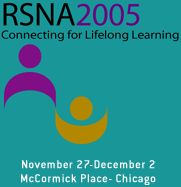
Abstract Archives of the RSNA, 2005
Bryson Borg MD, Presenter: Nothing to Disclose
Michael Terrence Modic MD, Abstract Co-Author: Nothing to Disclose
Lorraine Ash MD, Abstract Co-Author: Nothing to Disclose
Jeffrey S. Ross MD, Abstract Co-Author: Nothing to Disclose
Stephen Hatem MD, Abstract Co-Author: Nothing to Disclose
Nancy A. Obuchowski PhD, Abstract Co-Author: Nothing to Disclose
Assess the prevalence of abnormal lumbar pedicle marrow signal on MRI and its significance as a marker of structural abnormalities in patients with low back pain.
To determine prevalence of marrow signal abnormalities in a symptomatic population, lumbar pedicles were evaluated for hyperintensity on T2W and STIR sequences in two separate cohorts: 1) 246 patients prospectively enrolled in an MR study of patients with acute low back pain or radiculopathy; 2) 400 patients who had undergone lumbar MR imaging, divided equally between men and women, with 100 subjects each in the age ranges of =60 years. To determine the association of pedicle hyperintensity with other structural abnormalities, positive cases from the above cohorts, as well as an additional 18 cases identified during routine clinical practice over a six-month period (along with any relevant associated imaging studies) were reviewed for additional morphologic abnormalities.
4/246 and 6/400 patients demonstrated abnormal marrow signal intensity within one or more pedicles for a prevalence of 1.6 and 1.5% respectively. 20/28 (72%) of patients with pedicle hyperintensity demonstrated an associated morphologic abnormality. 8/28 (28%) had evidence of a pars fracture (with or without listhesis), 3/28 (11%) pedicle fracture, 5/28 (18%) severe degenerative facet and disc disease, 2/28 (7%) were post operative and 2/28 (7%) had degenerative spondylolisthesis. Pars and pedicle fractures were not always obvious or evident on the MR exam.
Pedicle marrow signal abnormality has a prevalence of 1.5% in patients with low back pain. While uncommon, it represents a marker for associated structural abnormalities, especially pars or pedicle fractures which might not be readily evident on MR alone.
Borg, B,
Modic, M,
Ash, L,
Ross, J,
Hatem, S,
Obuchowski, N,
MR Pedicle Marrow Signal Abnormalities. Radiological Society of North America 2005 Scientific Assembly and Annual Meeting, November 27 - December 2, 2005 ,Chicago IL.
http://archive.rsna.org/2005/4411060.html

